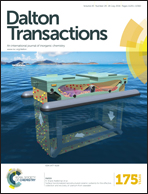An insight into the optical properties of a sub nanosize glutathione stabilized gold cluster†
Abstract
In this study, gold quantum clusters with distinct fluorescence properties were developed and their structural and physical behaviour was evaluated. The clusters were prepared by etching gold nanoparticles with glutathione. Three different Au33 clusters with emission profiles in the NIR region and one blue emitting cluster, Au8 were developed by varying the geometrical arrangement of atoms within the cluster. These clusters having sizes in the range of 0.7 to 2 nm were synthesized by choosing different reaction temperatures from 0 °C to 70 °C and pH between 1.5 and 10. In the three cases, formation of self assembled atoms within the cluster and the corresponding changes in optical properties were observed. A detailed evaluation of the number of atoms and the core–ligand ratio using MALDI-MS and a change in the binding energy as seen in the XPS study confirmed this finding. The study demonstrates that the self assembly of atoms and their arrangement is an important factor in determining the characteristics of the cluster. In this communication, we put forward a new concept where the number of atoms and their arrangement within the clusters play a crucial role in tuning their optical properties.


 Please wait while we load your content...
Please wait while we load your content...